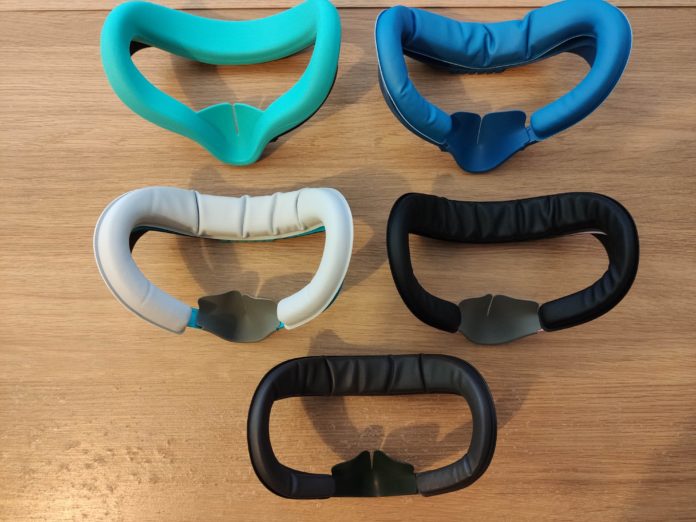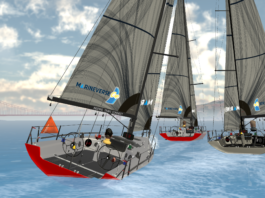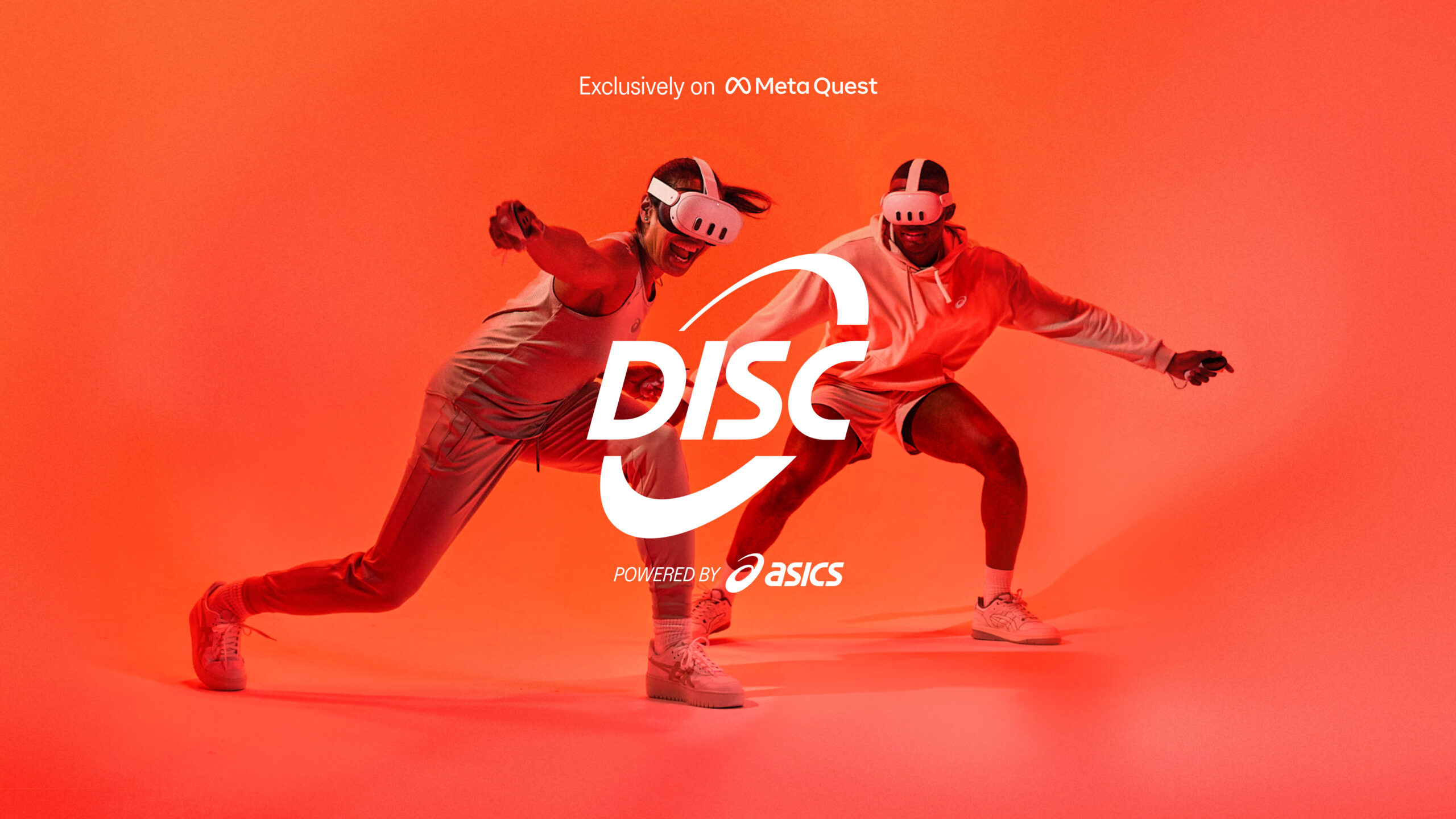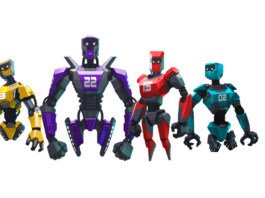If you’ve got a Quest 2 and use it regularly you’ll likely already have taken steps to improve its comfort through the purchase of third-party head straps, facial interfaces, and face pads. Having a comfortable headset that fits well on your face can make a big difference to your long-term enjoyment of virtual reality. You’ll be able to stay immersed for longer, losing yourself in the experience.
One factor you might not have considered, however, is just how each facial interface and face pad might impact your field of view. Can certain face pads allow you to see more of the screen than others, and are they still comfortable to use? That’s what this article is all about.
VRCover has sent me out all of their foam face pad sets to review and I’m going to put them all head to head, rating them across multiple criteria so that you can determine the best foam facial pads for you. I’m going to be taking a look at the following products;
Silicone Cover – The most basic, affordable no-frills option. A silicone cover is a simple face pad that wraps around the stock Oculus foam pad to prevent it from filling with sweat.
Standard replacement facial interface and foam pads – This is VRCover’s bread and butter, the sets that have made them famous. A replacement interface and two faux leather foam pads, one slim fit to let you get closer to the lenses, and a larger comfort pad.
Cool XG Gel foam replacement set – Two foam pads, one slim, one comfort, made with a cooling gel designed to give some cooling relief during short exercise sessions.
Minimal Foam pad – VRCover’s newest release. These two pads have been reduced to their thinnest size ever to allow your eyeballs to get as close as possible to the lenses, for an enhanced field of view (FOV).
Scoring Criteria
All four of these products meet their primary intended goal of providing the user with better sweat protection and an easily wipeable surface to clean, therefore I won’t score them on this criteria.
Instead, I’ll focus on price, comfort, ease of use, FOV, and overall value. I’ll then use these scores to pick my winner and hopefully provide you, the reader, with some clear pointers as to what is the best purchase for you.
I will attempt to be as rigorous and scientific as possible but bear in mind that absolute objectivity is impossible when reviewing facial interfaces and foam pads for comfort and FOV, given that our heads, facial shapes, and interpupillary distances (IPD) are all unique. That said, I do think it’s possible to make comparisons in a reasonable way, and that my own findings and results will be relatable to most users.
ROV Tool

When it comes to assessing FOV differences, there is a very handy tool available at the Steam Community Workshop. The ROV Test FOV & Resolution app is well worth subscribing to. It offers a veritable laboratory of headset-related tests, of which the FOV test is of interest to us for this article. Put simply, it allows you to measure both the viewable vertical and horizontal FOV distances so that we can accurately compare potential FOV improvements across the various VRCover foam pad options.
HMD Geometry Database
Another important tool to know about is Risa2000’s hmdq tool. This is essentially a set of command-line tools for VR headsets with support for both OpenVR and Oculus runtimes that can extract useful data information for the HMD Geometry database. Specifically, it can calculate a headset’s rendered FOV, ie. the maximum vertical and horizontal field of view each headset is rendering. If you’ve ever argued with another person as to whether a Reverb G2 has a larger or smaller FOV than a Quest 2, this tool settles the argument once and for all. The database is fascinating if you’re curious about FOV’s so check it out here.
According to the hmdq tool the Quest 2’s rendered FOV is 104 horizontal and 98 vertical. This is what the headset is rendering, and therefore the maximum FOV available to us. In the tests that follow we’ll see which foam pads get us the closest to these maximums, determine if the extra view helps increase immersion and whether comfort suffers.
Ok, let’s get started.
![]()
Silicone Cover. $14
Made from medical-grade silicone, you simply place this cover over the existing foam pad that comes with the Oculus Quest 2 headset. With no replacement facial interface required to buy this is the most affordable way to sweatproof your Oculus device. VRCover uses an unoiled silicone that is hypoallergenic and therefore should not irritate your skin. If your only concern is providing sweatproof protection to your Quest, then this will do the job. It’s ideal if you only occasionally engage in active VR games, or if you want a cheap cover that you can put on for when friends and family members use your headset, and you don’t want their sweaty scalps on your own more deluxe foam pad replacement.
Silicone covers do certainly have some downsides, however. Silicone is hardly the most luxurious material to put against your face. It has a noticeable odor, a bit like latex balloons, doesn’t feel particularly soft and pleasant on the skin, and attracts dust like no other material I know. As the cover fits over the existing foam pad and interface that comes with the Quest, you obviously won’t get any gain of FOV. Finally, it’s a real chore to take on and off. Silicone covers to me feel like they belong in a VR arcade, a no-frills product that does its intended job and no more, kind of like 3D glasses at the cinema. It’s handy to have one as a spare for when guests visit, but if you’re going to spend a lot of time in your VR headset, I’d treat yourself to something a little nicer.
Scores
Price – 9/10 – The cheapest way to sweatproof your headset.
Comfort – 6/10 I’m not a fan of how silicone feels against my skin or its slight chemical odor.
Ease of use – 6/10 These are easy to use but having to wrap them around the stock foam pad is not as attractive as having an easily removable interface replacement that you get with the more luxurious VRCover set.
FOV – 5/10 This setup, using the existing Quest interface and foam pad offers the lowest FOV in my testing at 90 Vertical 92 Horizontal
Value -6/10 A silicone cover will effectively sweatproof your device for an affordable price, but it’s a bit like putting an unbranded, plain bar of hand soap in your newly renovated bathroom, it cheapens the overall aesthetic. Those FOV numbers are low too, we can do much better.

Facial Interface & Foam Replacement Set $29
These sets are what VRCover has built its reputation upon. Replacing not just the Oculus stock foam pad, but the entire plastic facial interface as well, these sets offer a significant comfort upgrade for just $29. The set comes with two foam pads, a slim fit, and a thicker comfort fit. The slim fit is my pick. The thinner size lets you get closer to the action, yet it retains all of the plushy pillow comforts of the thicker model. If a silicone cover is a plain, unbranded soap, this is a luxurious, divinely scented, moisturizing hand lather.
Scores
Price – 9/10 You are paying double the price of a silicone cover, but with two luxurious covers and a replacement facial interface you get a lot more for your money.
Comfort 10/10 These foam pads are pillows for the face, offering a significant upgrade over the stock Oculus foam.
Ease of use 9/10 Being able to whip the interface out after use for cleaning, and then put it back with a simple click into place saves time and makes sanitizing your headset less of a chore.
FOV 7/10 The slim pad gives me a FOV of 92 Vertical 94 Horizontal, a modest increase over the stock interface and silicone cover, but still nice to have.
Value 9/10 In my opinion, this set is simply the most important upgrade you can get for your Oculus Quest 2. It simplifies sweat protection and headset cleaning, whilst also making your headset more comfortable, and slightly increasing the FOV.
NOTE – If you are a glasses wearer and wish to wear them inside the headset you will need to purchase the VR Cover Facial Interface Spacer for an additional $9. In that case, deduct a point from all of the above scores.
Specialty FOV Boosting Covers
In the past month, VRCover has released two new foam pad sets, to be used in conjunction with the facial interface set. You will need to already own a facial interface replacement set as these products sell as foam pads only, marking these out as enthusiast-level products.
Let’s take a look at them.

Cool XG Foam Replacement Set. $29
EDIT – At the time of publishing these are selling for a reduced price of $19. If you can get them for that price they represent much better value, so add a couple of points to the price and value scores)
These foam pads contain a cooling gel layer inside that provides a temporary cooling sensation, which VRCover claims is ideal for shorter VR sessions. You get two foam pads, one slim fit, one comfort fit. When using these I did indeed feel a slight difference in temperature when putting my headset on, but the effect was mild and quickly forgotten. I also noticed the gel pads are not nearly as plushy as the foam pads. The slim pad in particular feels quite hard against my face and is not nearly as comfortable, as I can feel the plastic of the interface. The larger pad is perfectly comfortable, but you lose FOV, and if that matters to you it makes its use redundant. For me, these gel foam pads are a swing and a miss by VRCover. They will set you back an additional $29 on top of the initial replacement facial interface set that you need to own to use these, and for me at least, are less comfortable to use than their standard foam pads. The slim cover does allow your eyes to get closer to the lenses than VRCover’s standard foam pads, however, so you do get a larger FOV. However, VRCover’s minimal foam pads, which we’ll look at next has it beat for FOV, and comfort too, leading to the XG Cool gel pads getting a no from me.
Scores
Price 5/10 The foam pads themselves cost $29, but you also need the replacement interface, which is $29 itself. For a near $60 outlay I’d want something spectacular in terms of comfort or FOV upgrade, which we don’t get here.
Comfort 6/10 The cooling gel does not have the same pillow effect as the standard VRCover foam pads. It’s harder against the skin and the slim one feels rather uncomfortable to me, I can feel the plastic interface through it. The larger size is more comfortable, but if you were buying for a larger FOV that eliminates the point of buying in the first place.
Ease of Use 5/10 The fact that you have to buy the facial interface replacement set first before you can use these is an unwelcome complication and expense.
FOV 8/10 The slim foam pad here does at least offer a nice FOV boost 98 vertical 98 horizontal.
Value 5/10 If there was an option to buy these with a facial interface to avoid the redundancy of having to pay for two stock foam pads as well these might have some value. At the current price though I don’t see any value in these. It’s not that the product is bad, it’s just double the price of the standard foam pads, which I actually prefer to these anyway, although you do gain some FOV with the slim XG gel foam pad.
If VRCover sold these covers with the facial interface for $29 or $39 they would be a much more attractive proposition.

Minimal Foam Replacement Set $19
VRCover’s most recent product launch is the minimal foam pad replacement. Like the Cool XG gel pad, you’ll need to purchase these separately from and in addition to the replacement interface set but they do use the same material as the standard foam pads, albeit slimmed down to allow your eyes to get as close to the lenses as possible. At $19 you are saving $10 over the gel foam pads and these are much, much better in my opinion.
Whilst the slim minimal foam pad looks at first glance as if it would be hopelessly inadequate to provide any forehead cushioning, somehow VRCover has managed to lose fully half the material without compromising comfort. It feels a lot more comfortable to me than the gel pads, whilst also providing the largest FOV of all the products tested. Even the larger, comfort-size foam pad is slimmer than VRCover’s standard slim foam pad, and every bit as comfortable to me. I really like this set, and whilst I wish you could purchase it with the standard facial interface, and not have to buy it separately, now I’ve been using the minimal foam pad for the past month, I cannot go back to the standard pads, as the FOV gain is immediately noticeable.
Score
Price 7/10 It’s unfortunate that there is no option to buy these with a facial interface as it increases the expense, but $19 isn’t a bad price for these pads that noticeably improve FOV and immersion.
Comfort 7/10 Obviously you’re trading some comfort here to get as close to the lenses as possible, but the tradeoff is absolutely worth it in my opinion. I’ve flown multiple two-hour flights in Microsoft Flight Simulator wearing the thinnest pad and it wasn’t uncomfortable for me.
Ease of Use 7/10 You’ll also need to also buy the replacement interface kit, but unlike with the gel foam, there is a clear FOV gain with these over the standard foam pads, whilst still maintaining comfort, which makes the extra purchase more justifiable.
FOV 9/10 – The minimal foam pad gets the maximum FOV score in my testing at 99 vertical 99 horizontal. With this pad, I can see right to the edges of the screens, and the usual tunnel-shaped appearance actually transforms to more of a squared view. It’s much less oppressive and it really does increase my feeling of immersion.
Value – 8/10 If you’re an enthusiast user who wants to maximize the FOV of your Quest 2, and can put up with a slight reduction in comfort, this is a very worthwhile purchase. If you aren’t bothered about the FOV or already struggle with headset comfort then this foam pad set likely won’t be worth it for you.

Summary – Is the FOV gain noticeable and worth it?
Caveats for spectacle wearers and wide IPD users.
Obviously wearing glasses inside the headset will prevent your eyes from getting up close and personal to the lenses, thus you will not be able to achieve these full FOV gains, but you probably expected this. For users with large IPDs using IPD setting 3 on the Quest 2, the edges of the lenses are already visible and cut off some of the FOV, so unfortunately your experience will be compromised too. The results below therefore relate to settings 1 and 2 only. The Quest 2 is a small headset and not great for users with larger IDPs sadly.
Ok, let’s evaluate the results. As the ROV app demonstrated, the FOV did indeed increase as we went through the various options, but mere numbers don’t reveal a lot so I thought I’d also provide a more narrative summary, detailing my experiences and what kind of impact a slight FOV increase has on practical usage.
FOV Rankings
- 99 vertical 99 horizontal – Minimal Foam Pad
- 98 vertical 98 horizontal – Cool XG Gel Foam Pad
- 92 vertical 94 horizontal – VR Cover’s Standard Slim Foam Pad
- 90 vertical 92 horizontal – Stock Interface With Silicone Cover
The minimal foam pad clearly gets the win, boasting a 9 point vertical FOV gain and an 8 point horizontal FOV gain over the stock interface with silicone cover and the replacement facial interface foam pads. But what does this look like through the headset?
Halfway to a Valve Index Resolution!
Now it goes without saying that it’s impossible to turn a small FOV headset like the Quest 2 into a large FOV headset like the Valve Index, there is simply less FOV being rendered by the headset, to begin with. Nonetheless, these results are impressive. Wearing a silicone cover on the stock Quest 2 facial interface, I get almost 10 degrees less viewable FOV both horizontal and vertical than with the VRCover facial interface and their minimal foam pad. According to the geometry database, the Valve Index renders 109 V and 109H, so those 9 degrees are halfway to a Valve Index field of view!
So what does this improvement actually look like?
Typically using a Quest 2 normally gives a rounded, tunnel-like view, with a large, black circular frame bordering the entire image. With the minimal foam pad this shape becomes less circular, and more square. Whilst it doesn’t dramatically allow me to see more, it does make the view inside the headset considerably less oppressive. Having those black circular borders thinned out is definitely a much more pleasant look for me and increases my feeling of immersion, even if I’m not seeing a whole lot more. With the standard pads, the Quest 2 reminds me of watching an ultra-widescreen movie on my TV so that I have black borders on top and bottom. The minimal pad halves the widths of those borders.
For that reason, I have switched over permanently to wearing the minimal foam pad. It isn’t quite as comfortable as the standard foam pads, but VRCover has managed to strike a perfect balance in my opinion, and the comfort to FOV tradeoff is absolutely worth it for me.
The minimal foam pad offers both extra FOV, without sacrificing comfort, and as such is now my favorite VRCover foam pad. Is it worth an additional $19 to reduce the circular border around your view? If you’re somebody who prioritizes visuals and takes VR seriously, I’d say absolutely. The tunnel effect is one of the major distractions to immersion, and whilst a simple foam pad mod can’t magically increase the capabilities of the Quest 2 headset and turn it into a Pimax, it will ensure you can press your eyeballs close enough to the screens to see every single degree of the rendered image displayed from your headset, and that for me is definitely worthwhile.
Ok, let’s wrap up with some recommendations;

Best comfort and value winner – Facial Interface & Foam Replacement Set $29
For most people this facial interface replacement and its two included foam pads will be the perfect complement to their Quest, luxuriously comfortable and easy to wipe clean, it’s my most essential Quest 2 accessory.
Best Field of View winner – The minimal foam pad set $19
You’ll also need to buy the Facial Interface & Foam Replacement Set separately, so it’s an additional purchase cost, but these foam pads ensure you get the maximum FOV for your headset, without sacrificing comfort too much. If you’re an enthusiast who wants the best view possible this set comes absolutely recommended.




